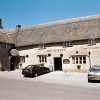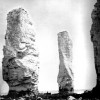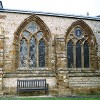Some say he was carved out two milleniums ago, to represent the Roman god Hercules. Pagan rites were certainly carried out there some four centuries ago. But some affirm that he is a bogus god-figure, created out of the Dorset hillside in the 17th or 18th centuries.
He is the Cerne Abbas Giant, fashioned in the chalk above that village, a few miles from Dorchester. At 180 feet (55 metres) high, he is the largest hill figure in Britain. The Rude Man as he is sometimes referred to carries a 120-foot club and this place has been the setting for fertility ceremonials and practices.
Visitors gazing from the viewing point look on in awe. Apart from the Long Man of Wilmington in East Sussex, there is nothing quite like this in England. If such a figure were created today, it would cause an outcry.
People climbing the giant’s steep hill are not much more than spots across the valley. On May Day, which must once have drawn crowds to this spot, the phallus points directly at the sun as it rises over the hill. The whole figure stretches two-thirds of the hill from top to bottom.
Dorset, Wiltshire and Oxfordshire have many hill figures. This one is associated with maypole dancing in an earth enclosure, the “Frying Pan”, located high up above the giant’s left arm, which may once have supported a cloak in classic fashion.
At the end of the second century AD the Emperor Commodus, a supposed reincarnation of Hercules, who campaigned in Britain, revived the worship of this god. But the Dorset figure may be associated with the adoration of various Romano-Celtic gods.
However, there is no actual reference to the giant to be found before 1694 when a payment in the Cerne Abbas churchwardens’ accounts of three shillings is recorded for the re-cutting of the figure. So we may be dealing with one of history’s hoaxes, performed perhaps by libertarians – on a colossal scale.
In 1751 the Dorset historian John Hutchins suggested that the figure was chiselled out in the mid-1600’s. It was depicted in the Gentleman’s Magazine of 1764. There is no reference in mediaeval documents. One theory is that monks at a monastery in the valley below created the giant as a joke. At any rate, local people have maintained the trenches, about half a metre wide and deep, down to the clay bedrock.
The Silver Well or Augustine’s Well, flows below the giant and has both pagan and Christian connections. Some even imagine the giant goes to the bottom of the hill for a drink from it at midnight. Actually, he would have to do little more than put down his club and stoop.
In the 17th century Lord Denzil Holles (1598-1680) was lord of the manor and it has been suggested his servants cut the figure while he was away. The roof leads on the aisles of a nearby church were repaired in 1800 and 1843, and since then have had reliefs of the giant. What does Christian spirituality have to say about that?
The whole subject is a curiosity. The inquirer keeps returning to the question of why there are no early records. Travellers in the Tudor and Stuart periods made no reference to the figure. Nor did the wealth of local mediaeval documents.
Then there is the question of the monks. For at least 500 years a Christian monastery stood looking up at the barbarous and brutish, not to say impolite form. How could the abbot and monks, and visiting church personages, the pillars of society, have tolerated it? For five centuries?
This gigantic figure with his knurled club stands watch over the villagers of Cerne Abbas. He has in fact a kind personality, for he can help childless couples produce heirs, or so they say.
Note: In the gallery there is an aerial view photograph of the Giant.



